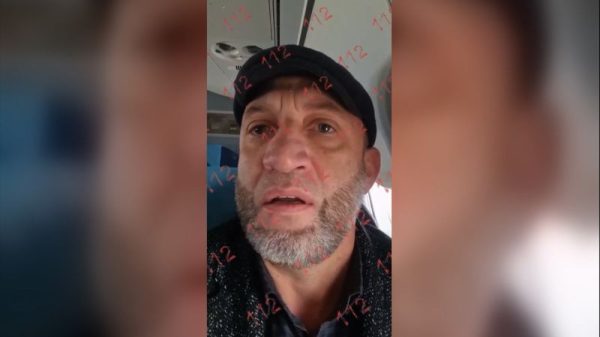The sun blisters the arid ground in Karnal, a district in India’s northern Haryana state, where empty houses stand testament to an acute problem that’s driving some residents to take unimaginable risks.
There are no jobs here, so young educated locals who dream of a better life are paying thousands of dollars to flee the world’s fastest growing major economy for the United States.
“It is the donkey way,” said law student Ankit Chaudhary. “It is a route which is going through many of the countries and then we will jump the wall of the USA.”
But he lost his money and the opportunity to flee when his agent was raided.
The risky journey is part of a worrying new trend in the country of 1.4 billion people, and one that could strain ties between the India and the US, where illegal immigration remains a key issue ahead of November’s presidential vote.
In just four years, the number of Indian citizens illegally entering the US has surged dramatically — from 8,027 in the 2018 to 2019 fiscal year to 96,917 during 2022 to 2023 period, government data showed.
Recent Pew research found that as of 2022, Indians made up the third-largest group of undocumented migrants in the US, behind people from Mexico and El Salvador.
The numbers speak to the desperation faced by Indians in the world’s largest democracy and stand in stark contrast to the powerful and robust image that Indian Prime Minister Narendra Modi is trying to project on the world stage. He’s aiming to turn the world’s most populous nation into a global superpower by 2047.
“Viskit Bharat (Developed India) is a nation where no one is too small to dream and no dream is too big to achieve,” Modi said in May. “Viksit Bharat is a nation where social circumstances or birth do not limit anyone’s growth. Everyone, no matter who they are, can aspire to reach the heights of success.”
But not everyone is convinced the dream is real.
Chaudhary is planning to apply for a US visa, but if that fails, he says he will have no choice but to take the dangerous illegal route out.
“People have no source of income, no government jobs. Some people are (hungry),” Chaudhary said. “I have no other option but to migrate.”
Too few jobs
There were no young people in sight. Instead, elderly men sat on the stoops outside some homes, smoking hookahs and shuffling cards.
The homes of parents whose children have settled abroad were easily identifiable; swanky bungalows with SUVs parked outside and tractors that had the American flag painted on them, bought with funds sent back home.
During the fiscal year from 2022 to 2023, the unemployment rate of people aged 15 and above in Haryana state stood at 6.1%, according to data released by India’s Ministry of Labour and Employment, nearly double the national average for the same period.
But for people age 15 to 24, the number was significantly higher – 45.4% across the country in the same year. Official unemployment rates in developing countries tend to be low because very few people can afford to be unemployed for long, so they take whatever work they can find, however inadequate.
“He was thinking about it for a long time,” Kumar said. “(There are) no jobs here … he wanted to go there and make money so the family could be happy.”
The family borrowed $30,000 from relatives and friends to pay an agent to smuggle Malkeet into the US via the now infamous “donkey route,” his brother said.
They said it involved taking a flight out of New Delhi and flying via countries with relatively favorable visa requirements, before landing in Latin America, if they are entering via the southern US border.
There, the migrants meet smugglers who then guide them through treacherous jungles to the US-Mexico border, where they wait to be picked up by border enforcement agents and request asylum. When asked, many have been trained to say they do not feel safe in India and that their lives are in danger, the families said.
Malkeet left India in February, first flying to Dubai before continuing to Almaty, Kazakhstan, according to his family. From there, he traveled to Turkey, where he transited in Istanbul airport for 24 hours, before boarding a plane to Panama City and then San Salvador.
There, he met with a smuggler and disconnected his phone before embarking on the toughest, most strenuous leg of the journey: north, towards Guatemala.
India’s population paradox
With an average age of 29 years, India has one of the world’s youngest populations, but the country is not yet able to reap the potential economic benefits of its young workers.
According to a March report by the International Labour Organization, educated Indians between the ages of 15 and 29 are more likely to be unemployed than those without any schooling, reflecting “a mismatch with their aspirations and available jobs.”
“The Indian economy has not been able to create enough remunerative jobs in the non-farm sectors for new educated youth labour force entrants, which is reflected in the high and increasing unemployment rate,” the report said.
Lawyer Muzaffar Chishti, director at the Migration Policy Institute in New York, said “push factors like these are what matter in the decision for people to make the journey.”
Chishti, who has been watching illegal immigration trends into the US, said: “If these young men and women know that there is a good chance, even a 50% chance that they will get into the US … that is a magnet.”
Until a recent Biden Administration crackdown on the border, there was reason to believe that embarking on the trip could bring success.
Many who have attempted the journey have vlogged about it, amassing tens of thousands of views on YouTube, Instagram and TikTok, all while selling the idea of “the American Dream.”
Ankush Malik, whose YouTube channel has close to 60,000 subscribers, is among those who have successfully crossed into the US via Mexico. He now works as a truck driver and often flaunts his wealth to his fans, boasting of buying $95 perfume, living in a large house and visiting multiple cities as a trucker.
But not every video paints a rosy picture.
Malik documented his entire journey from Haryana to the US, flying via Qatar and Amsterdam, before reaching Panama to begin his jungle trek. In one of the videos, the men appear weak and tired, dripping in sweat, with bug bites on their legs and arms, while staying on the lookout for other critters as they stop to rest for the night.
One of the migrants looks at the camera with sullen eyes and a rugged beard. Pale and hungry, he says: “10 lakh rupees ($12,000) has gone to waste. They’ve made a donkey out of us.”
Claiming asylum
If they make it to the US, the migrants’ unpredictable journey begins to follow a typical routine as they wait for Customs and Border Protection officers to pick them up, according to Chishti.
“The customs official first must determine whether the person is in physical danger or not. Whether they’re malnourished or not,” he said.
“They give them a bottle of water. At that point, the person (who just crossed into the US) says ‘I’m here to seek asylum.’”
According to US law, if someone claims asylum, they must be given a hearing to make their case. While they wait, the customs official takes them to a processing facility, where they’re given a medical screening. Security checks are conducted, and the migrants are interviewed.
Following the screening, the official decides whether to consider their asylum application, which could take years to process.
While in the US, asylum applicants can apply for employment authorization and must wait at least 180 days for a work permit.
In 2023, 46% of asylum claims from Indian nationals were approved, according to the Justice Department.
Earlier this summer the Biden Administration issued an executive order largely barring migrants from seeking asylum at the US southern border and levying harsh consequences on those illegally crossing.
US Border Patrol have since reported a dramatic drop in illegal cross border traffic. In September, Border Patrol officers reported around 54,000 encounters, the lowest number recorded since 2020.
But contrary to his claims, US authorities found he faced no persecution in India, and he was eventually sent home.
The man wanted to remain anonymous as he is attempting to make the trip yet again. “I don’t earn enough while farming here,” he said.
An agent from Haryana, who did not want to be named for legal reasons, said he has sent between 150 to 200 people via the “donkey route” to the US.
But this month, the agent said conditions for migrants had changed dramatically.
“There has been an increase in the number of people being deported for certain,” he said. “This has caused fear in those going illegally and the agents involved in the donkey route.”
The agent said he has completely stopped his work.
“Most people are now holding off going to the United States via donkey,” the second agent said. “They do not want to spend thousands of dollars for nothing.”
As he campaigns for a return to the White House, Trump has made clear his views on immigration, blaming migrants for everything from rising crime to eating people’s pets.
“Our country is being lost, we’re a failing nation,” Trump said in September’s presidential debate with Democratic nominee Kamala Harris.
“In my opinion the donkey route will never completely stop,” said the first agent.
“Even earlier during Trump’s time, we sent people. There will be newer routes, networks, and ways one may have to devise to get there.”
‘It has become do or die’
Kumar waited anxiously at home in India as his brother Malkeet embarked on the donkey route from India last year.
Malkeet sent images of his plane tickets and selfie videos along the way before setting off on the riskiest leg, the trek north through Guatemala.
Kumar had hoped for news that his brother had made it. Instead, he received videos that confirmed he hadn’t.
“We got videos (of his dead body) via many WhatsApp groups. Someone showed it to us and asked if it was my brother and we identified him,” Kumar said.
The family learned Malkeet had been shot and killed by criminals on a riverbank on the El Salvador-Guatemala border.
Malkeet’s body was returned to them nearly five months later.
“It is impossible to fill the loss of my brother,” said Kumar, who now toils on his family’s fields alone.
But despite the tragedy, people remain undeterred. Kumar says young people in his village still dream of smuggling themselves somewhere overseas
“People here know they will die from unemployment, so they think it is better to go and take the risk,” he said. “For people here it has become do or die.”







































